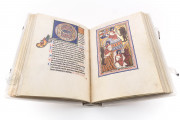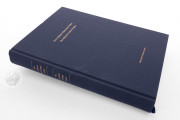One of the most lavishly illuminated books of its kind from the Middle Ages, the Munich Golden Psalter is a manuscript designed for Christian private devotion. Its text is the biblical book of Psalms—with additional biblical poetry, prayers, and creeds—preceded by a liturgical calendar. It was created in Oxford around 1200 and was perhaps commissioned by Walter de Lacy for Margaret de Braoze, whom he married in late 1200 or 1201. It boasts ninety-one full-page miniatures, most of which include gold.
The Golden Psalter's miniatures include subjects rarely found in the art of the period, and the pictorial program is remarkable for its attention to the stories of four Old Testament "heroines": Ruth, Esther, Judith, and Susanna. Twelve of the initials to the ancillary texts—canticles, prayers, and creeds—are historiated, an unusual feature.
From Creation to Final Judgment
The manuscript's miniatures—all full-page and containing from one to six scenes—are grouped to precede the texts of Psalm 1 (fols. 8-30), Psalm 52 (fols. 65-72), Psalm 101 (fols. 104-111), Psalm 109 (fols. 121-122), and the biblical Canticles (fols. 146-149). The longest series, the prefatory cycle, embraces scenes, mostly two to a page, from Creation to the Fall of Jericho followed by scenes from the infancy and Passion of Christ extending past the Resurrection.
Dazzling Miniatures
The Golden Psalter's miniatures feature a palette dominated by gold, red, and blue. The figures, their solid forms defined by heavy drapery, gesture boldly. Some of the paintings have thick painted frames ornamented with geometric and foliate motifs. The extensive series of nearly 250 individual scenes is the work of three artists and one or two assistants.
Made for a Woman
One factor suggesting that the book was made for a woman is the unusual inclusion of scenes from the stories of Ruth, Esther, Judith, and Susanna, which are grouped—together with scenes from the lives of Samuel and Jonah—before Psalm 101. Each of the sixteen miniatures of this group includes six scenes arranged in three registers under painted arcades.
On the Cusp
The main text of the Munich manuscript was written by two scribes, one responsible for the calendar and the other for the devotional texts. They both wrote the Transitional Script of the long twelfth century. A third scribe (or two more scribes) writing in an informal Gothic Textualis made three additions to the calendar and supplied captions identifying subjects of many of the Old Testament scenes in black and identifying scenes from the public life of Christ in red.
Every page of the manuscript is a feast for the eye: each psalm is introduced by a painted initial, either inhabited or decorated and the remaining psalm verses begin with a colored capital letter alternating between red and blue. Each verse ends with a pen-flourished line filler, also alternating red and blue.
Maximilian's Book
The earliest clear sign of ownership is a bookplate—datable to 1618—of Maximilian I (1573-1651), Elector of Bavaria. The holdings of the Munich court library formed the foundation collection of the Hof- und Staatsbibliothek in 1829, renamed the Bayerische Staatsbibliothek in 1919. The manuscript's current binding of white suede over wooden board dates from the mid-twentieth century.
We have 1 facsimile edition of the manuscript "Munich Golden Psalter": Der Goldene Münchner Psalter facsimile edition, published by Quaternio Verlag Luzern, 2011
Request Info / Price



























